Tag Archive: behavior
November 4, 2018
by Carole Zangari -
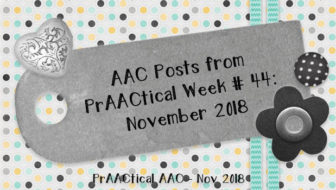
Happy November, AAC friends! Here are some posts you may have missed in your busy week. Monday – PrAACtically November: AAC Resources for a Year of Core Vocabulary Tuesday – AAC Link Up Wednesday – Video of the Week: Talk AAC with Me Thursday – Building AAC Facilitation Skills with Tabi Jones-Wohleber: MASTER PAL Training, Module 11 (Let the Child Lead) ::::::::::::::::::::::::::::::::::::::::::::::::::::::::::::::::::::::::::::::::::::::::::::::::::::::::::::::::::::::::::::::::::::::::::::::: Have room for a little more AAC in your day? Here’s a sampling to choose from. Beyond Behavior Problems: How Visual Supports Can Help Our AAC Teaching AAC Intervention: 5 Activities with PrAACtical Potential AACtual Therapy: Positive Behavior Management with Gail Bennell Daylight Savings Time and Behavior Extension Activities for AAC Practice And, finally, if working with young children who have complex communication needs is your thing, we invite you to join us for a full day of preschool AAC in January. (Use the sliding bar on the right to navigate... [Read More...]
Filed under: Featured Posts, PrAACtical Thinking
Tagged With: activities, behavior, preschool, summary post
April 6, 2017
by Carole Zangari -
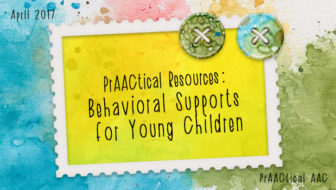
One of the biggest stressors for therapists and educators who work with AAC is dealing with challenging behavior. In today’s post, we share a wonderful set of resources on positive approaches to preventing, minimizing, and de-escalating instances of challenging behavior. The Technical Assistance Center of Social Emotional Intervention for Young Children produced a number of resources that are available on their website here. Topics include: Tips and forms for getting started Using a Buddy System Teacher tools Turtle Technique Visual supports Using scripts Circle time tips Dealing with feelings Strategies for families to use at home There is also a helpful Tool Kit that can be accessed via the image below.
Filed under: Featured Posts, PrAACtical Thinking
Tagged With: behavior, positive behavior supports, preschool
November 30, 2016
by Carole Zangari -
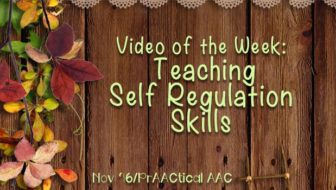
When working with learners who use AAC, we often overlook instructional strategies or programs designed for students without disabilities or those with high incidence disabilities. That means we may be missing out on approaches that may be effective for our students. In fact, many AAC learners can benefit from well-designed instruction that was developed for individuals with different kinds of challenges. In this week’s featured video, we return to one of our favorite sources of instructional information, Kansas TASN, to learn more about teaching young children to build their self-regulation skills. Dr. Kristie Pretti-Frontczak discusses a 5-step process for teaching self-regulation to young children during play, giving ample information on how to implement each step. While this approach may not be ideal for all AAC learners, it may well be helpful for some of the students with whom you work. Many thanks to TASN and KSDE Early Childhood, Special Education and... [Read More...]
Filed under: Video of the Week
Tagged With: behavior, instructional strategies, play, self-regulation
January 27, 2016
by Carole Zangari -
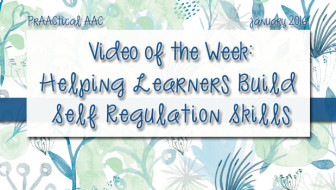
Communication and behavior, as we all know, are deeply intertwined. In this week’s featured video, we hear from Lindy McDaniel, the author of one of my favorite blogs, The Considerate Classroom. In this video, Lindy guides us to think about some of the tools and strategies that we can use to help young learners build their self regulation skills. I appreciate the prAACtical nature of the information and tips, along with the video examples that she shares in this presentation. Many thanks to the fine folks at TASN for making this available. You can see other posts featuring Lindy’s work here and here.
Filed under: Video of the Week
Tagged With: behavior, Self-Calming, TASN
May 17, 2013
by Robin Parker -

We have had several experiences in the last couple of weeks relating to concerns from SLP’s and educators about challenging behavior (dare we say it might be less structure, less predictability, less routines, or just plain tiredness because it is the end of the school year). Challenging behavior is hard… and disconcerting especially if you feel that you have little control over it (imagine how the learner feels- almost no one wants to be unhappy and out of control). However, there are so many strategies and supports that can improve the situation. It is often about getting back to basics (especially if end of the year issues play into the challenging behavior). The First 5 Questions to Ask: How Does the Learner Communicate? It is important that everyone has a way to communicate their own wants, needs, ideas, interests, and more. It is NOT good enough to just ‘know’ what someone... [Read More...]
Filed under: PrAACtical Thinking
Tagged With: behavior, Challenging Behavior, visual supports
November 18, 2012
by Carole Zangari -
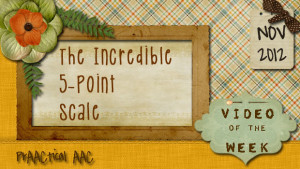
In an earlier post we listed some of our favorite strategies that aren’t as widely used as they could be in AAC intervention. Among them, was qualitative rating scales, or Likert-type scales. We use them for a variety of purposes and love their potential for expressive communication. – In this video, from From Autism and Tertiary Behavior Supports Project of the Kansas Technical Assistance Network, you’ll learn one way of using simple rating scales to help people with ASD regulate their own behavior. We like the detailed implementation information presented in The Incredible 5-point Scale. –
Filed under: Video of the Week
Tagged With: behavior, intervention, positive behavior support
July 22, 2012
by Carole Zangari -
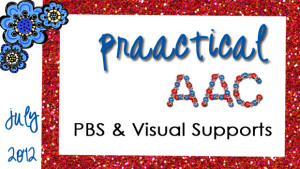
This week’s video comes from Katie Thomas of the Autism and Tertiary Behavior Supports Project of the Kansas Technical Assistance Network and deals with the who, what, when, where, and why of using visual supports to promote positive behavior. – There are several supporting documents including the PowerPoint handout, and some of the supports they review (e.g., calendar, first/then, wait card). We love the detailed description and the many examples they share. – Click here to view the video. –
Filed under: Video of the Week
Tagged With: ASD, behavior, implementation ideas, intervention, resources, visual supports
July 21, 2012
by Carole Zangari -
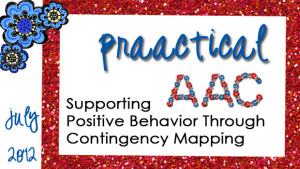
This month we’re focusing on visual supports and strategies to support positive behavior. We’ve talked about transition supports and environmental arrangements. Another way to help therapy sessions run smoothly and keep the focus on learning (rather than managing behavior) is to take proactive steps to make the expectations clear. For most people who are learning AAC, that means making sure there is a visual representation that accompanies the verbal explanation. – Many SLPs create a list of rules for expected behavior. In this post, we’ll talk about the research-supported strategy of using contingency maps. Contingency maps are a visual depiction that shows the desired behavior and the outcomes of two divergent paths: one where the learners engage in the desired behavior and the other that shows what happens if they don’t engage in the desired behavior. If you’re familiar with behavioral approaches, this strategy is right up your alley. The... [Read More...]
Filed under: Strategy of the Month
Tagged With: ASD, behavior, contingency map, developmental disability, intellectual disability, positive behavior support, visual supports
July 15, 2012
by Carole Zangari -
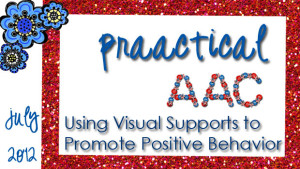
This week we have a series of short videos from the Geneva Centre for Autism on strategies to support positive behavior. Enjoy these explanatory videos on Supporting Positive Behaviors During Changes, Change in Routine, and Learning to Wait. –
Filed under: Video of the Week
Tagged With: ASD, behavior, implementation ideas, intervention, visual supports
July 14, 2012
by Robin Parker -
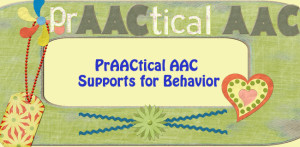
Our July Strategy of the Month, PrAActical AAC Supports for Behavior, is a favorite topic for us, because with a little planning, we can adhere to the old adage that an ‘ounce of prevention is worth a pound of cure’ (as Carole said last week). We also find that behavior challenges are often one of the main reasons, our students (and colleagues) get stressed about working with children with significant communication impairments. And since stress for ANYONE does not make for an optimal learning environment, we love to show how effective preventative strategies work. This week we are focusing on ‘setting the stage’ for conventional and appropriate behavior by engineering the physical environment. We are talking about more than keeping the room neat, clean, and generally organized. We are talking about arranging the physical environment in a planned and careful way in order can make a huge difference in helping... [Read More...]
Filed under: Strategy of the Month
Tagged With: behavior, behavior management, visual supports









